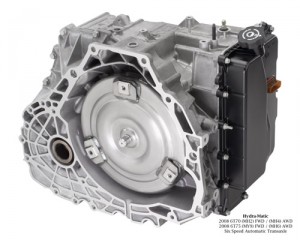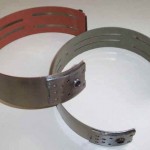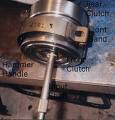
2008 Hydra-Matic 6T70 (MH2) FWD Six Speed FWD
General Motors new Hydra-Matic 6T70 six-speed automatic transmission, an advanced automatic  transmission with clutch-to-clutch shift operation for front and all-wheel drive vehicles, debuted in the all-new 2007 Saturn Aura midsize sedan. Co-developed with Ford Motor Co., the new six-speed joins the already announced Hydra-Matic six-speed rear-wheel drive family of automatics and Allison 1000 six-speed automatic as part of GM’s mission to produce 3 million six-speed automatics annually by 2010.
FYI—GotTransmissions.com can provide you with G.M. transmission immediately if the situation were to occur.
The 6T70’s clutch-to-clutch operation allows for reduced complexity and compact packaging. A wide, 6.04:1 overall ratio spread helps the transmission deliver both performance and fuel economy, enabling up to 8 percent improved performance and up to 4 percent improved fuel economy when compared with current front-wheel drive four-speed automatics.
Co-development of the transmission allowed it to reach production in less time and enabled each company to reduce development costs by as much as 50 percent. A common design and many common components are shared between GM and Ford six-speed variants, but each company developed its own controls and calibrations to tailor the shift feel of the transmission to fit their brand characteristics.
Rated for engines up to 315 horsepower and 280 lb.-ft. of torque, the 6T70 helps maximize powertrain performance and economy through its wide 6.04:1 ratio – the spread in gear ratios between first gear and sixth gear. This configuration allows for a “steep†4.48:1 first gear, which helps deliver exceptional launch feel, and a 0.74:1 overdrive sixth gear – the “tall†overdrive gear lowers rpm at high speeds, reducing noise, vibration and harshness. Fifth gear is 1:1 or direct drive.
“The additional gear states are almost like having two transmissions in one…The low first gear provides tremendous off-the-line acceleration, but the transmission is able to use the middle gears to evenly distribute the torque and offers an overdrive sixth gear that helps delivers great fuel economy.
Shorter steps between the gears, compared with a four-speed automatic, enhance performance and feel, as the transmission quickly finds the best gear for the vehicle speed and road conditions – there’s less “hunting†(shift busyness) on grades, for example. Also, the 6T70 offers the capability of driver shift control (DSC), which allows the driver to use tap-up, tap-down shifting to select the desired gear for specific road conditions, such as driving up a steep hill.
The Hydra-Matic 6T70’s highlights also include:
- Compact dimensions of 357 mm in length and 197 mm in width for packaging convenience in a variety of front- and all-wheel drive vehicles with transverse-mounted powertrains – one the most compact transmissions in its competitive set
- Clutch-to-clutch shift operation for all shifts except 1-2 reduces mechanical complexity and mass while enhancing shift feel
- Integrated transmission electro-hydraulic control module (TEHCM) with driver shift control and performance algorithm shifting for shift feel and timing tailored to the driver
- Internal control module reduces powertrain complexity
- Auto grade braking and shift mode capability
- Heat-treated gears are honed for a more precise fit, reducing noise, vibration and harshness
- Narrow torque converter enhances packaging and maintains efficiency
- Simple, less complex design has reduced number of seals
- Adjustable capacity vane-type pump enhances fuel economy compared with non-adjustable gear-type pump
Although used in some low-volume high-performance sports cars and luxury sedans, six-speed transmissions are rare in most high-volume midsize cars and SUVs. GM and Ford Motor Co. recognized a need for a transmission that could accommodate increased powertrain performance while delivering excellent fuel economy. The compact size and reduced complexity afforded by the clutch-to-clutch design allowed engineers to answer the call for performance and economy with six forward speeds.
The 6T70’s advanced clutch-to-clutch operation is designed for smooth shift feel and packaging efficiency. All shifts except 1-2 (the transmission “free wheels†in first) feature clutch-to-clutch operation. This is achieved through three planetary gears, with three stationary clutches and two rotating clutches. It’s a simple, less complex design that enables the packaging of six gears in the space of a four-speed automatic.
A sophisticated transmission electro-hydraulic control module (TEHCM) is mounted inside the 6T70, reducing vehicle complexity. Similar to the control system used in the Hydra-Matic 6-speed rear-wheel drive transmissions, the TEHCM offers improved quality through its hard-wired connections and pre-calibration.
The unit is located entirely within the transmission and operates while bathed in transmission fluid. Locating the controller internally facilitates the modular design and assembly strategy while also shielding the unit from the outside environment.
Although it is not uncommon to have a transmission-control module that adapts to the specific transmission with which it is mated, and to also have programming that optimizes transmission performance characteristics according to a variety of vehicle inputs, the new Hydra-Matic six-speed automatic adds another level of adaptability. Certain components within the major subsystems that make up the transmission also “learn†from one another – via the controller software – in a unique form of self-adaptation that maximizes the interface of all the “networked†components. This procedure takes place as the transmission “tests†itself and the interaction of its internal components before it is shipped from GotTranmsissions.com.
.
The TEHCM enables a host of performance-oriented and driver-controllable shift features, including performance algorithm shifting (PAS), driver shift control (DSC) “tap shift†and auto-grade braking.
The Hydra-Matic 6T70 is manufactured at GM’s Warren Transmission plant. It debuted in summer 2006, when production began on the 2007 Saturn Aura.
As always, be true to the maintenance needs of your transmission and expect longer life out of it.
Stay tuned to the GotTransmissions.com blog for more information on some of the new breed of transmissions.






